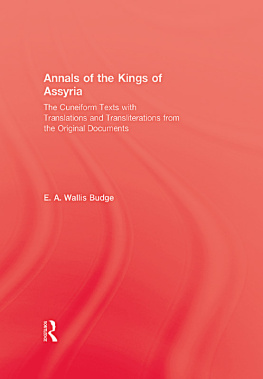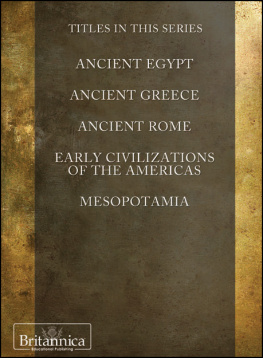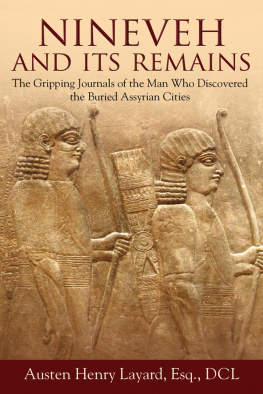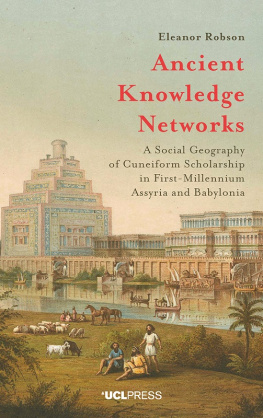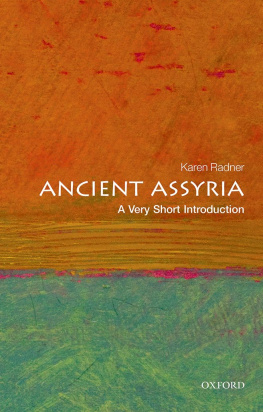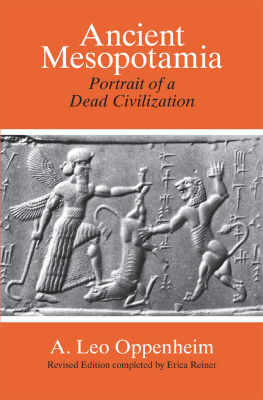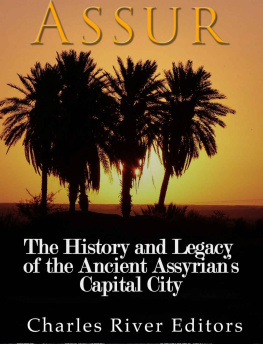ROUTLEDGE LIBRARY EDITIONS: ARCHAEOLOGY
Volume 39
PEOPLE OF ANCIENT ASSYRIA
PEOPLE OF ANCIENT ASSYRIA
Their Inscriptions and Correspondence
JRGEN LSSE
Translated from the Danish by
F. S. LEIGH-BROWNE
First published in 1963
This edition first published in 2015
by Routledge
2 Park Square, Milton Park, Abingdon, Oxon, OX14 4RN
and by Routledge
711 Third Avenue, New York, NY 10017
Routledge is an imprint of the Taylor & Francis Group, an informa business
1963 Danish Det Schnbergske Forlag
1963 English Routledge & Kegan Paul Ltd
All rights reserved. No part of this book may be reprinted or reproduced or utilised in any form or by any electronic, mechanical, or other means, now known or hereafter invented, including photocopying and recording, or in any information storage or retrieval system, without permission in writing from the publishers.
Trademark notice: Product or corporate names may be trademarks or registered trademarks, and are used only for identification and explanation without intent to infringe.
British Library Cataloguing in Publication Data
A catalogue record for this book is available from the British Library
ISBN: 978-1-138-79971-4 (Set)
eISBN: 978-1-315-75194-8 (Set)
ISBN: 978-1-138-81385-4 (Volume 39)
eISBN: 978-1-315-74786-6 (Volume 39)
Publishers Note
The publisher has gone to great lengths to ensure the quality of this book but points out that some imperfections from the original may be apparent.
Disclaimer
The publisher has made every effort to trace copyright holders and would welcome correspondence from those they have been unable to trace.
PEOPLE OF ANCIENT ASSYRIA
Their Inscriptions and Correspondence
by
JRGEN LSSE
Translated from the Danish by
F. S. LEIGH-BROWNE
First published in Denmark as
FRA ASSYRIENS ARKIVER
by Det Schnbergske Forlag
This translation first published 1963
by Routledge & Kegan Paul Ltd
Broadway House, 68-74 Carter Lane
London, E.C.4.
Printed in Great Britain
by T. & A. Constable Ltd
Hopetoun Street, Edinburgh
English translation
Routledge & Kegan Paul Ltd 1963
No part of this book may be reproduced in any form without permission from the publisher, except for the quotation of brief passages in criticism
To
PROFESSOR C. E. SANDER-HANSEN, Ph.D.
I AM indebted to Professor M. E. L. Mallowan, Director of the British School of Archaeology in Iraq (Gertrude Bell Memorial), for permission to reproduce photographs I took during the excavations at Nimrd.
The three maps in this book were prepared by M. E. Knop, Chief Topographical Officer of the Geodetic Institute, Copenhagen, on the basis of my sketches. My sincere thanks are due to him for this outstanding contribution.
Danish Oriental research owes a considerable debt to the Egyptologist, Professor C. E. Sander-Hansen, Ph.D. In thankful recognition of his interest and support over many years, I beg Professor Sander-Hansen to accept the dedication of this book to himself.
J. L.
INTRODUCTION

W AS Assyria merely a more brutal, more uncivilized and less interesting offshoot of the culture created by Sumerians and Babylonians in Southern Mesopotamia at the dawn of history? Do the countless Assyrian reliefs that fill our museums give a complete picture of the phenomenon that was Assyria? Was the contribution of this people to world culture merely an incredibly effective military organization? Is it a true picture of Assyria that the reliefs and annals give us, with their presentation of war chariots, archers, battering-rams surrounding besieged cities, the punishment of prisoners of war, and the triumphal march of the Assyrian army through the realms of the Near East? Have we no evidence of the human element behind this phenomenon? How far may we rely on the Biblical descriptions of the cruelty of the Assyrian armies and the depravity of Assyrian cities? How are we, who can look back on the incredible events of the European wars of religion, on the conduct of Europeans towards the Indians of America, and on mans recent treatment of his fellow-man, to judge these Assyrians? The answer to many of these questions is to be sought rather in the personal documents of the time than in the official inscriptions, in the letters Assyrians wrote to one another rather than in the annals of their rulers. Truth resides more often in the letters from one human being to another: distortion of facts often insinuates itself more easily into public proclamations intended for contemporary or subsequent acceptance. Therefore, in an attempt to rehabilitate the Assyrians and to provide a truer picture on which to base their reputation, their official inscriptions are, with few exceptions, excluded from this book. The basis of presentation here consists of historical sources that must in every respect be regarded as primary, namely the correspondence discovered in excavating the archives of Assyrian kings and governors.
It is impossible to offer such a presentation without mentioning the achievements of a number of Assyriologists. The Mari letters that form the basis of , with Plates 153, respectively).
The Sargon Chronicle translated on 196): the Assyrian eponym-lists (catalogues of officials holding the post of limmu, used for dating in northern Mesopotamia) have been treated by Ungnad under the entry Eponymen of the same work (pp. 412457). For the neo-Assyrian period the last-named article is supplemented by Margarete Falkners important contribution, Die Eponymen der sptassyrischen Zeit, in the periodical Archiv fr Orientforschung, Vol. 17, pp. 100120 (Graz, 195455).
The latest history of the kingdom of Mittanni is by R. T. OCallaghan: Aram Naharaim (Analecta Orientalia, 26, Rome, 1948); and that of the Hurrians in general by I. J. Gelb in his book Hurrians and Subarians (Chicago, 1944). The comprehensive material on Hurrian personal names from Yorghan Tepe has been dealt with by I. J. Gelb, P. M. Purves, and A. A. MacRae in


